Robert Gould Shaw
| Robert Gould Shaw | |
|---|---|
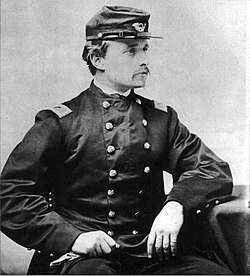 Shaw in May 1863 | |
| Born |
October 10, 1837 Boston, Massachusetts, U.S. |
| Died |
July 18, 1863 (aged 25) Morris Island, South Carolina |
| Allegiance |
|
| Service/ |
|
| Years of service | 1861–1863 |
| Rank |
|
| Unit |
7th New York Militia 2nd Regiment Massachusetts Volunteer Infantry |
| Commands held | 54th Massachusetts Infantry Regiment |
| Battles/wars | |
Robert Gould Shaw (October 10, 1837 – July 18, 1863) was an American soldier in the Union Army during the American Civil War. Born into a prominent abolitionist family, he accepted command of the first all-black regiment (54th Massachusetts) in the Northeast and encouraged the men to refuse their pay until it was equal to the white troops' wage. At the Second Battle of Fort Wagner, a beachhead near Charleston, South Carolina, Shaw was killed while leading his men to the parapet of the Confederate held fort. Although they were overwhelmed and driven back, Shaw's leadership passed into legend with a unit that inspired tens of thousands more African-Americans to enlist for the Union and contribute to its ultimate victory.
Early life and education
Shaw was born in Boston to abolitionists Francis George and Sarah Blake (Sturgis) Shaw, who were also well-known Unitarian philanthropists and intellectuals. The Shaws had the benefit of a large inheritance left by Shaw's merchant grandfather and namesake Robert Gould Shaw (1775–1853), and Shaw himself would have been a member by primogeniture of the Society of the Cincinnati had he survived his father.[1] Shaw had four sisters— Anna, Josephine (Effie), Susanna, and Ellen (Nellie).[2]
When Shaw was five years old, the family moved to a large estate in West Roxbury, adjacent to Brook Farm. During his teens he traveled and studied for some years in Europe. In 1847, the family moved to Staten Island, New York, settling among a community of literati and abolitionists while Shaw attended the Second Division of St. John's College at Fordham at the behest of his uncle Joseph Coolidge Shaw, who had been ordained as a priest in 1847 after becoming a Catholic during a trip to Rome in which he befriended several members of the Oxford Movement. Robert began his high school-level education at St. John's in 1850, the same year Joseph began studying there for entrance into the Jesuits.[3]
In 1851, while still at St. John's, Shaw's uncle died from tuberculosis. 13 at the time, Shaw had a difficult time adjusting to his surroundings and wrote several despondent letters home to his mother. In one of his letters, he claimed to be so homesick that he often cried in front of his classmates.[3] While at St. John's, he studied Latin, Greek, French, and Spanish, and practiced playing the violin, which he had begun as a young boy. He left St. John's prematurely in late 1851 when the Shaw family departed for an extended tour of Europe. He then entered a boarding school in Neuchâtel, Switzerland where he stayed for two years. Afterwards, his father relocated him to a school with a less strict system of discipline in Hanover, Germany, hoping that it would better suit his restless temperament.[3] While in Hanover, he enjoyed the greater degree of personal freedom his new school afforded him, on one occasion writing home to his mother, "It's almost impossible not to drink a good deal, because there is so much good wine here."[3]
While Robert was in Europe, Shaw family friend Harriet Beecher Stowe published Uncle Tom's Cabin. Shaw read the book multiple times and was moved by its plot and anti-slavery attitude. Around the same time, Shaw wrote that his patriotism had been bolstered after encountering several instances of anti-Americanism among some Europeans. He expressed interest to his parents in attending West Point or joining the Navy. Because Robert had had a longstanding difficulty with taking orders or obeying authority figures, his parents did not view this ambition seriously.[3]
Shaw returned to the United States in 1856. From 1856 until 1859 he attended Harvard University, joining the Porcellian Club,[4] and the Hasty Pudding Club,[3] but he withdrew before graduating. He had been a member of the class of 1860. Shaw found Harvard no easier to adjust to than any of his previous schools and wrote home about his discontent.[3]
After leaving Harvard in 1859, Shaw returned to Staten Island to work with one of his uncles at the mercantile firm Henry P. Sturgis and Company but found life at the company office disagreeable.[3]
American Civil War
_-_full.jpg)
Early in the American Civil War, Shaw joined the 7th New York Militia as a private and on April 19, 1861, marched down Broadway in lower Manhattan with it to the defense of Washington, D.C.[5] On May 28, 1861, Shaw was formally commissioned as a second lieutenant into Company H of the 2nd Massachusetts Infantry, with which he fought in the first Battle of Winchester, and the battles of Cedar Mountain, and Antietam.[6]
The use of black soldiers to fight the Confederates was advocated early in the war by John A. Andrew, the war time Governor of Massachusetts. When the Union government finally adopted this policy Andrew traveled to Washington in January, 1863. After a conference with Secretary of War Stanton, Andrew received orders under which the Fifty-fourth Massachusetts Volunteer Infantry was created and organized. In a letter of January 20, 1862 Governor Andrew wrote to Robert's father, Francis Shaw, inquiring about the prospects of finding suitable commanders for the new regiment. In offering the younger Shaw, via his father, the commission Andrew expressed his hopes about finding a suitable leader who would accept the responsibility of this command, "...with a full sense of its importance, with an earnest determination for its success."[7]
Subsequently Shaw was approached by his father while in camp in Virginia in late 1862 with Andrew's offered commission to take command of a new all-black regiment. At first, he declined the offer, but after a day of deliberation and careful thought,[8] knowing a commander who was akin to Massachusetts politicians and their effort to incorporate black soldiers was needed, he accepted the position and telegraphed his father with his decision.[9] Shaw's letters clearly state that he was dubious about a free black unit succeeding, but the dedication of his men deeply impressed him, and he grew to respect them as fine soldiers. Captain Shaw arrived in Boston on February 15, 1863, and immediately assumed command of the 54th Regiment and the duties of his position.[10] On learning that black soldiers would receive less pay than white ones, he joined in with his unit on their boycott until this inequality was rectified. The enlisted men of the 54th Massachusetts Infantry (and its sister unit, the 55th Massachusetts) refused pay until Congress granted them full back pay at the white pay rate in August 1863.[11]
Shaw was promoted to major on March 31, 1863, and to colonel on April 17.[12]
On June 11, 1863, Shaw wrote about war crimes committed against the citizens of Darien, Georgia, when the civilian population of women and children were fired upon, forced from their homes, their possessions looted, and the town burned. Shaw noted in a letter, "On the way up, Montgomery threw several shells among the plantation buildings, in what seemed to me a very brutal way; for he didn't know how many women and children there might be." Shaw was initially ordered by Colonel James Montgomery to perform the burning but he refused. Shaw noted in a letter, "The reasons he gave me for destroying Darien were, that the Southerners must be made to feel that this was a real war, and that they were to be swept away by the hand of God, like the Jews of old. In theory it may seem all right to some, but when it comes to being made the instrument of the Lord's vengeance, I myself don't like it." He goes on to say, "We are outlawed, and therefore not bound by the rules of regular warfare; but that makes it nonetheless revolting to wreak our vengeance on the innocent and defenceless."[13]
Ironically, the original Scottish founders of Darien had signed the first Petition against the Introduction of Slavery in the colony of Georgia.
Second Battle of Fort Wagner
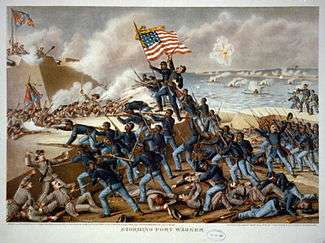
Colonel Shaw and the 54th Regiment were placed under the command of General Quincy Gilmore and sent to Charleston, South Carolina to take part in the second attempt to defeat the Confederate garrison stationed there. The fort was well armed with an assortment of heavy guns and whose overall strength was underestimated by Union command.[14] At the battle, July 18, 1863, along with two brigades of white troops, the 54th assaulted Confederate batteries at Fort Wagner. As the unit hesitated in the face of overwhelming Confederate fire, Shaw led his men into battle by shouting, "Forward, Fifty-Fourth, forward!" He mounted a parapet and urged his men forward, but was shot through the chest three times and died almost instantly. According to the Color Sergeant of the 54th, he was shot and killed early in the battle while trying to lead the unit forward and fell on the outside of the fort.[15][16] Some Confederate reports claim his body was hit a total of seven times. The battle had continued to 10 p.m. which ended with heavy Union losses. Among the other fatalities was Gen. George Crockett Strong, mortally wounded; Col. Haldimand S. Putnam shot and killed instantly; Col. John Lyman Chatfield, mortally wounded.[17] Shaw's 54th Regiment suffered the heaviest losses.[18] The Confederates buried Shaw in a mass grave with many of his men, an act they intended as an insult.[19]
Two sons of Fredrick Douglass, Charles Douglass and his eldest son, Lewis Douglass, belonged to the 54th regiment. Lewis was wounded at the Battle of Fort Wagner shortly after Shaw fell, and barely managed to retreat to safety.[20]
Following the battle, commanding Confederate General Johnson Hagood returned the bodies of the other Union officers who had died, but left Shaw's where it was. Hagood informed a captured Union surgeon that "Had he been in command of white troops..." he would have returned Shaw's body, instead of burying it with the fallen black soldiers[21]
Although the gesture was intended as an insult by the Confederates, it came to be seen as an honor by Shaw's friends and family that he was buried with his soldiers. Efforts had been made to recover Shaw's body (which had been stripped and robbed prior to burial). However, his father publicly proclaimed that he was proud to know that his son was interred with his troops, befitting his role as a soldier and a crusader for emancipation.[22] In a letter to the regimental surgeon, Lincoln Stone, Frank Shaw wrote:
We would not have his body removed from where it lies surrounded by his brave and devoted soldiers....We can imagine no holier place than that in which he lies, among his brave and devoted followers, nor wish for him better company. – what a body-guard he has![23]
After the war, the Union Army disinterred and reburied all the remains—including, presumably, those of Col. Shaw—at the Beaufort National Cemetery in Beaufort, South Carolina, where their gravestones were marked as "unknown".[24] Shaw's sword was soon robbed from the gravesite but was recovered in 1865 and returned to his parents, where it eventually disappeared again. In June 2017 it was discovered in a family attic of Mary Minturn Wood and brother, descendants of Shaw's sister Susanna.[25]
Personal life
On May 2, 1863, Shaw married Anna Kneeland "Annie" Haggerty (1835–1907) in New York City. They decided to marry before the unit left Boston despite their parents' misgivings. They spent their brief honeymoon at the Haggerty place, Ventfort, in Lenox, Massachusetts.[26]
Widowed at 28, Annie Shaw never remarried. She lived with her family in New York, in Lenox, Massachusetts, and abroad, a revered figure and in later years an invalid. She died in 1907 and is buried at the cemetery of Church-on-the Hill in Lenox.[27]
Shaw is well known for the over 200 letters he wrote to his family and friends during the Civil War.[28] They are currently located in the Houghton Library at Harvard University. Digital facsimiles of this collection are publicly available. The book, Blue-Eyed Child of Fortune, includes most of his letters and a brief biography of Shaw. Peter Burchard also used these letters as the basis for his book One Gallant Rush.
Memorials
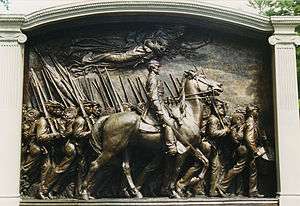
- A cenotaph at the Mount Auburn Cemetery
- In 1864, sculptor Edmonia Lewis created a bust of Shaw.
- Shaw's story is dramatized in the 1989 film Glory, starring Matthew Broderick.
There they march, warm-blooded champions of a better day for man. There on horseback among them, in his very habit as he lived, sits the blue-eyed child of fortune, upon whose happy youth every divinity had smiled.
— Oration by William James at the exercises in the Boston Music Hall, May 31, 1897, upon the unveiling of the Shaw Monument.[1]
- Some drawings and plaster mock-ups also exist.[29] A patinated plaster cast of a slightly different design for the Shaw Memorial is now on display at the National Gallery of Art in Washington, D.C..[30] The inscription running along the bottom of the plaster cast incorrectly states that the assault on Fort Wagner and Shaw's death in 1863 occurred "JULY TWENTY THIRD," five days later than the actual events.
- A monument to Shaw's memory was erected by his family in the plot at Moravian Cemetery in Staten Island, New York. An annual commemoration is held there on his birthday.
- Although he did not graduate, Shaw's name is listed on the tablets of honor in Harvard University's Memorial Transept.
- In 1921, the M Street Junior High School in Washington, D.C., was renamed the Robert Gould Shaw Junior High School in Shaw's honor. The school moved locations twice and was closed in 2013.[31]
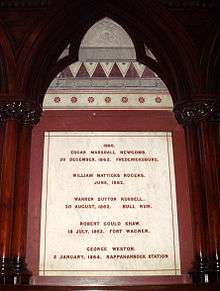 Entry for Shaw in Harvard University's Memorial Hall |
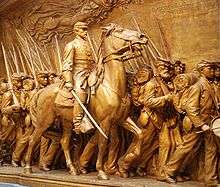 Memorial to Shaw and the 54th Regiment at the National Gallery of Art, plaster replica |
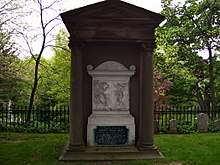 Shaw memorial at the renown Mount Auburn Cemetery, in Massachusetts |
Legacy
- The story of Shaw and the 54th Massachusetts is dramatized in the 1989 film Glory, with Shaw portrayed by Matthew Broderick.
- Shaw, the 54th regiment, and Augustus Saint-Gaudens's memorial are one of the subjects of Charles Ives's composition for orchestra, Three Places in New England.
- The New England poet Robert Lowell referenced both Shaw and the Shaw Memorial in the poem "For the Union Dead" which Lowell published in his 1964 book of the same name.
- African-American poet Paul Laurence Dunbar wrote a poem entitled "Robert Gould Shaw", in which he states: "Since thou and those who with thee died for right/Have died, the Present teaches, but in vain!"[32]
- African-American poet Benjamin Griffith Brawley wrote a memorial poem entitled "My Hero"[33] in praise of Robert Gould Shaw.
- The neighborhood of Shaw, Washington, D.C., which grew out of freed slave encampments, bears his name.
- G.A.R. Post #146, established on December 4, 1871, was named The R. G. Shaw Post in New Bedford, Massachusetts, and was one of the first all colored (African American) Grand Army of the Republic posts, made up of patriotic comrades of the 54th Massachusetts. Due to lack of funds, the Shaw Post dissolved in 1881.
- In 2017, the sword that Shaw was carrying when he was killed was discovered among the artifacts in the attic of a family home in Hamilton, Massachusetts. The owners, siblings Robert Shaw and Mary Minturn Wood, donated it to the Massachusetts Historical Society, where it went on public display on July 18, the anniversary of his death.[34]
Gallery
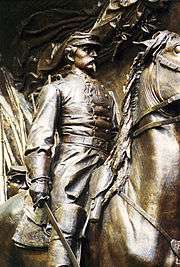 |
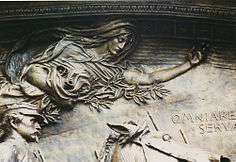 |
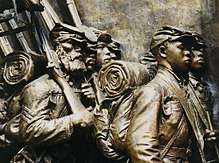 |
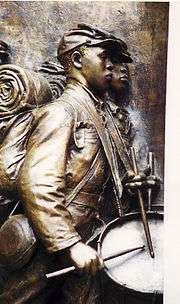 |
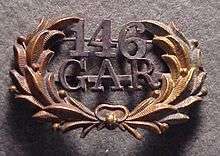
See also
References
- 1 2 Boston City Council (1897). Exercises at the dedication of the monument to Colonel Robert Gould Shaw and the Fifty-fourth regiment of the Massachusetts infantry (May 31, 1897). Boston: Municipal Printing Office.
- ↑ "Caroline Wells Healey Dall journal, 1862-1865, pages with entries for 6-8 August 1863". Massachusetts Historical Society. Massachusetts Historical Society. Retrieved 16 January 2017.
- 1 2 3 4 5 6 7 8 "Fordham Preparatory School: Col Robert Gould Shaw". www.fordhamprep.org. Retrieved 2017-05-09.
- ↑ Catalogue of the Porcellian Club of Harvard University. Boston: Harvard university. Porcellian club. 1877. p. 54. Retrieved 16 January 2017.
- ↑ Burchard, Peter, "One Gallant Rush: Robert Gould Shaw and his Brave Black Regiment," St. Martin's Press, 1965. ISBN 0-312-04643-X pp. 29-31
- ↑ Hickman, 2017, Essay
- ↑ Emilo, 1894, pp.1
- ↑ Wise, 1994, p. 48
- ↑ Emilo, 1894, pp.5
- ↑ Emilo, 1894, pp.6
- ↑ Duncan, 1999, p. 118
- ↑ Miller, Connie (2008). Frederick Douglass American Hero: and International Icon of The Nineteenth Century. Xlibris Corporation. p. 238. ISBN 9781441576491. Retrieved 16 January 2017.
- ↑ Shaw, Robert Gould. "Written in Glory:Letters from the Soldiers and Officers of the 54th Massachusetts". Retrieved 29 April 2013.
- ↑ Emilo, 1887, p.12
- ↑ Foote, 1986, pp. 697-698
- ↑ Emilo, 1894, p.92
- ↑ Emilo, 1894, pp.85-87
- ↑ Emilo, 1887, p.16
- ↑ Lodge, pp. 109-110
- ↑ Kendrick, 2008, pp.138-140
- ↑ Foote 2003, p. 119
- ↑ Buescher, John. "Robert Gould Shaw." Teachinghistory.org. Accessed 12 July 2011.
- ↑ Foote 2003, p. 120
- ↑ "Remembering the Civil War Fallen at Beaufort, SC" (PDF). U.S. Dept of Veteran's Affairs. Retrieved February 15, 2018.
- ↑ "Civil War Col. Robert Gould Shaw's long-lost sword found in attic". CBS News. July 13, 2017. Retrieved February 15, 2018.
- ↑ Hawthorne's Lenox, Cornelia Brooke Gilder with Julia Conklin Peters, Hawthorne's Lenox. The History Press, 2008. ISBN 978-1-59629-406-6 pp.71–76
- ↑ Gilder, Cornelia Brooke; Olshansky, Joan R. (2002). "A History of Ventfort Hall". Lenox: Ventfort Hall Association. pp. 6–7. Missing or empty
|url=(help) - ↑ Duncan, Russell (1992). Blue-Eyed Child of Fortune The Civil War Letters of Colonel Robert Gould Shaw. Athens, Georgia: University of Georgia Press. ISBN 0820314595.
- ↑ National Gallery of Art (2011). "Augustus Saint-Gaudens". Artist. Washington, DC: National Gallery of Art.
- ↑ Saint-Gaudens, Augustusartist. "Shaw Memorial, 1900". The Collection. National Gallery of Art. Archived from the original on 2011-10-25. Retrieved 2012-01-19.
- ↑ "Names are given to three schools" (PDF). The Evening Star. 7 June 1921. Retrieved 5 June 2017.
- ↑ Dunbar, Paul Laurence. "Robert Gould Shaw". Poems.
- ↑ Brawley, Benjamin Griffith (1922). "My Hero". In James Weldon Johnson. The Book of American Negro Poetry, With an Essay on the Negro's Creative Genius. New York: Harcourt, Brace and Company.
- ↑ Puschmann, Sarah B. (July 25, 2017). "'Holy Grail of Civil War Swords' Found in Massachusetts Attic". Live Science. Purch Group. Retrieved 2017-08-02.
Sources
- Dhalle, Kathy, A Biography of Robert Gould Shaw
- Duncan, Russell (1992). Blue-Eyed Child of Fortune: The Civil War Letters of Robert Gould Shaw. University of Georgia Press. ISBN 0-8203-1459-5.
- —— (1999). Where Death and Glory Meet: Colonel Robert Gould Shaw and the 54th Massachusetts Infantry. University of Georgia Press. ISBN 978-0-8203-2136-3.
- Emilio, Luis Fenollosa (1887). The assault on Fort Wagner, July 18, 1863. Boston, Rand Avery company.
- —— (1894). History of the Fifty-Fourth Regiment of Massachusetts Volunteer Infantry, 1863-1865. Boston : Boston Book Co.
- Foote, Lorien (2003). Seeking the One Great Remedy: Francis George Shaw and Nineteenth-century Reform. Ohio University Press. ISBN 0-8214-1499-2
- Hickman, Kennedy. "Civil War: Colonel Robert Gould Shaw". About Education. About, Inc. Retrieved 16 January 2017.
- Kendrick, Paul; Kendrick, Stephen (2008). Douglass and Lincoln. Walker & Company,.
- Lodge, Henry Cabot (1895). Hero Tales from American History.
- NcFeely, William (2017) [1991]. Frederick Douglass. New York: W.W. Norton. ISBN 978-0-3936-3411-2.
- Shelby, Foote (1986) [1963]. The Civil War, a Narrative, Fredricksburg to Maridan. Vintage Books, New York. ISBN 978-0-3947-4621-0.
- Simpson, Brooks (2013), The Civil War: The Third Year. The Library of America (2013)
- Wise, Stephen R. (1994). Gate of Hell: Campaign for Charleston Harbor, 1863. Univ of South Carolina Press. ISBN 978-0-8724-9985-0.
- Fifty-fourth Massachusetts Infantry history
- Further reading
- Benson, Richard, Lay This Laurel : An album on the Saint-Gaudens memorial on Boston Common, honoring black and white men together, who served the Union cause with Robert Gould Shaw and died with him July 18, 1863, Eakins Press, 1973. ISBN 0-87130-036-2
- Cox, Clinton, Undying Glory: The Story of the Massachusetts 54th Regiment, New York: Scholastic, 1991.
- Egerton, Douglas, Thunder at the Gates: The Black Civil War Regiments That Redeemed America, New York: Basic Books, 2016. ISBN 9780465096640
- Robert Lowell, For the Union Dead, Collected Poems, Farrar, Straus, Giroux, 2003, ISBN 0-374-12617-8
- Burchard, Peter One Gallant Rush—Robert Gould Shaw & His Brave Black Regiment, St. Martin's Press, 1965. ISBN 0-312-03903-4
- The Master by Colm Toibin relates Wilkie James's (younger brother of Henry and William James) participation as an officer in the regiment.
External links


- Colonel Robert Gould Shaw: 54th Massachusetts Regiment on YouTube
- NHD Robert Gould Shaw – National History Day on YouTube
- Robert Gould Shaw Letters to his Family and Other Papers (MS Am 1910) at Houghton Library, Harvard University